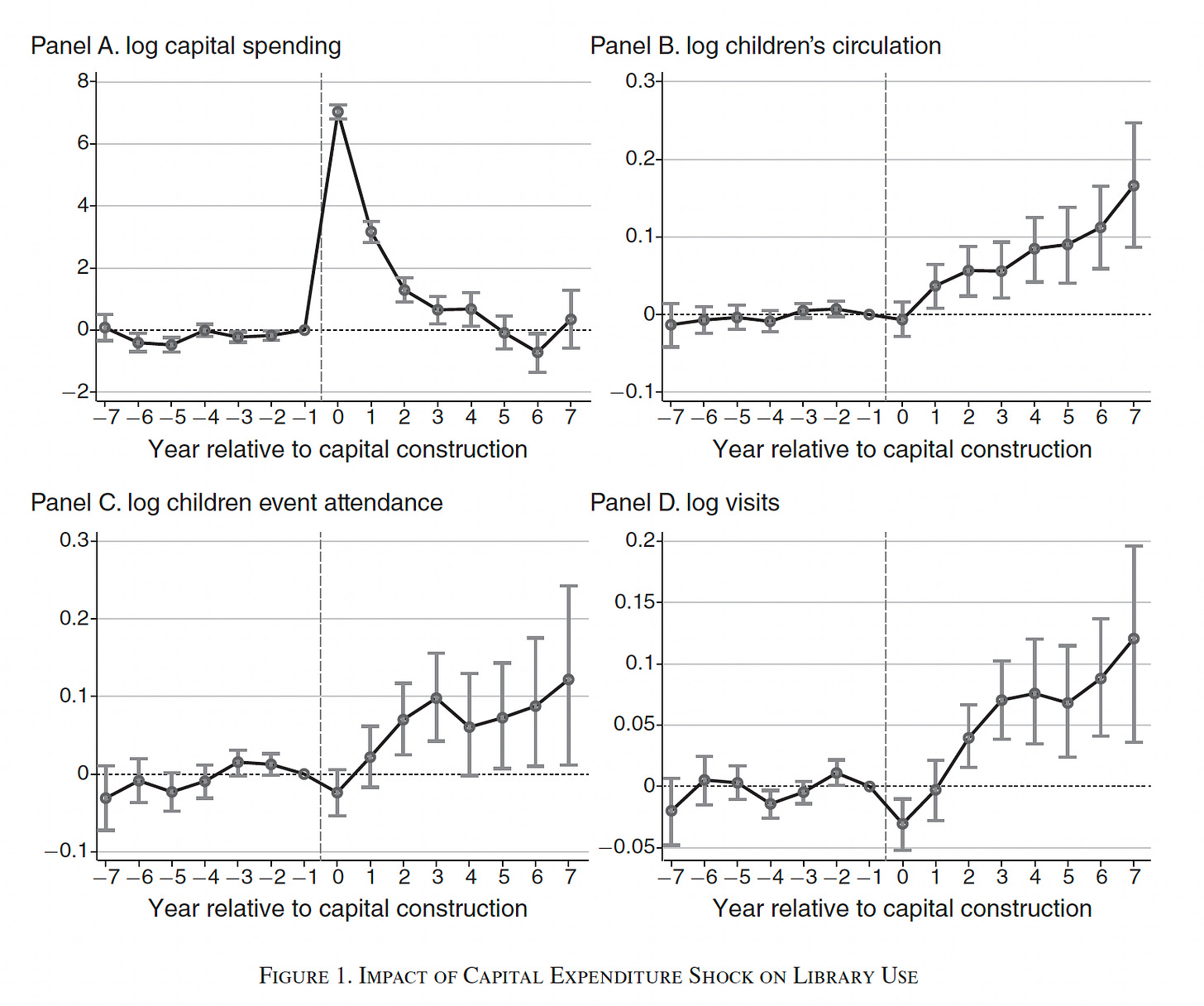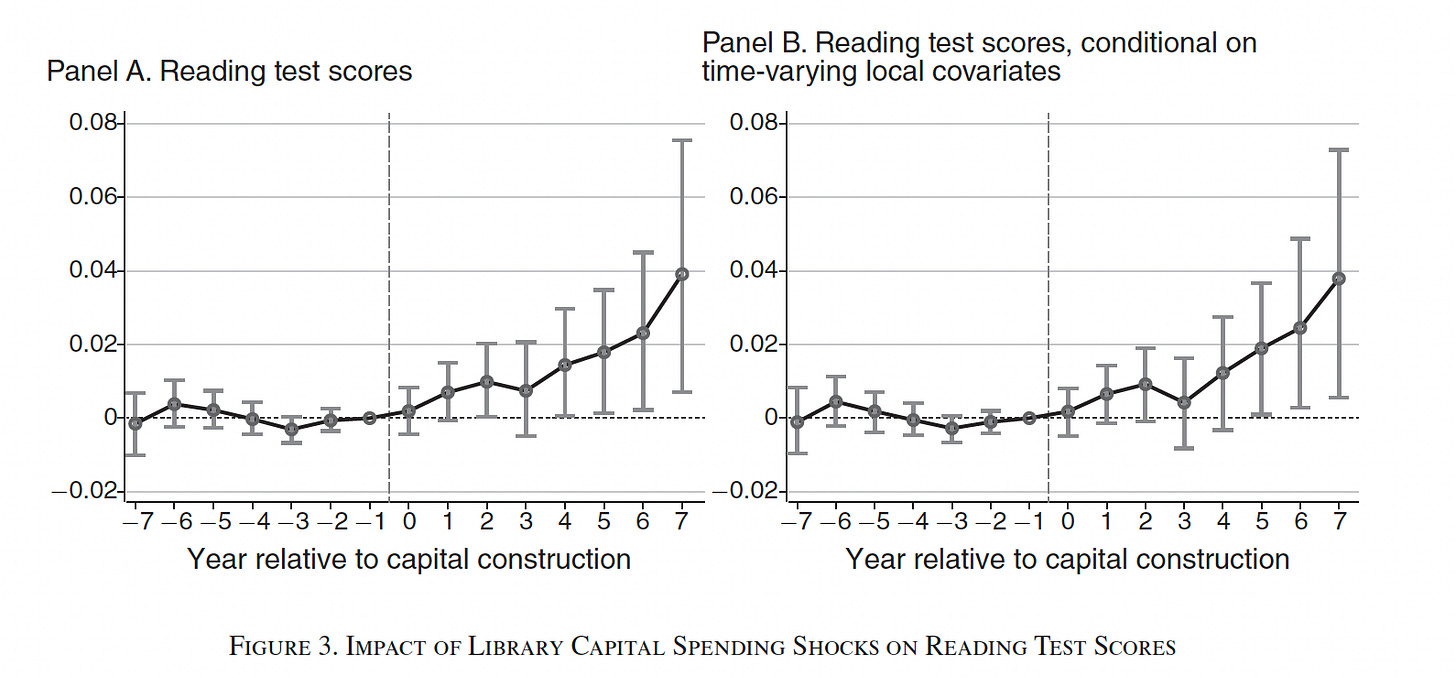Spending on Local Libraries and Student Outcomes
Libraries and Economic Development
This post is part of a series I am working on, focusing on the importance of local libraries and economic development. Read more at the end of this post about the reason behind the development of this series. I could use your help!
Do Libraries Help Improve learning and Community Well-being?
Every year, U.S. communities spend over $12 billion operating more than 17,000 public libraries. But do these investments actually make a difference? How do they improve community well-being?
Economists Gregory Gilpin, Ezra Karger, and Peter Nencka1 decided to find out. In one of the most comprehensive studies of its kind, published by the American Economic Journal: Economic Policy, they analyzed nearly three decades of library data to measure the impact of community investment in libraries.
Their goal was to:
Estimate how investment in public libraries affects library operations, patron usage, and local communities, focusing on student achievement.
The Study
Using data from the Institute of Museum and Library Services (IMLS) and linking it to student test scores from the Stanford Education Data Archive, the researchers tracked the impact of capital investments, major renovations, or new library buildings across thousands of U.S. communities between 1992 and 2018. To capture house prices, they collected zip-code-level pricing data from Zillow and the Federal Housing Finance Agency (FHFA).
Because these projects occur sporadically and independently of other local policies, they create a natural experiment and allow us to test for the impact of those investments.
Natural Experiments
Economists care deeply about what causes what. Correlation isn’t enough; just because two things move together doesn’t mean one caused the other. Instead of running tests in a lab, economists look for real-world events such as new laws, policy changes, or unexpected shocks that affect some people but not others. That’s where natural experiments come in. By comparing these groups, they can see how a change in one area leads to different outcomes in another. It’s one of the most powerful ways economics turns messy real-life data into measurable insight.
The Results
When a community invests in its public library, significant and lasting changes occur.
Library visits increase 21%.
Children’s book checkouts jump 21%.
Attendance at children’s events rises 18%.
These gains persist for at least a decade after the investment is complete.
And the impact doesn’t stop at the library’s doors.
Reading test scores in nearby schools rise by 0.01-0.04 standard deviations on average.
The effect is largest in smaller districts and those with lower school capital spending, suggesting libraries may compensate where school infrastructure falls short.
No similar effect appears for math scores, which is consistent with libraries’ focus on reading and literacy.
These outcomes occur with local and large public library investment. Small capital investments do not yield the same outcome.
Put simply: invest in a library, and reading scores rise.
The Cost and Benefit
The researchers benchmarked their findings against school infrastructure spending. On a per-dollar basis, library investments produced test-score improvements comparable to, or greater than, those from new school construction. However, those gains come in at a fraction of the cost.
This doesn’t mean libraries replace schools. It means they amplify them. They create the conditions, access, curiosity, and quiet spaces, where learning continues beyond the classroom. Libraries provide space for the community to come together across all socioeconomic levels.
Interestingly, the study found no change in local housing prices following the construction of the new library. Homeowners valued the new amenities enough to offset the small tax increases that funded them.
The Bottom Line
Access to information in a digital world has increased drastically, leading to skepticism about the need for physical libraries. However, that neglects a lot of what libraries provide beyond books. Libraries are not relics of a pre-digital age. They are infrastructure for opportunity, places where access to information translates into measurable academic and social returns. Their value is in providing access and opportunity for the local community. What people forget is that libraries offer services that local communities need, beyond just access to books. Stop by your local library or visit their website and see how much community building and support they provide.
In an era where public spending is considered inefficient use of money, here is an example of how public spending can improve access and success in our communities.
Reader Question: How has your library shaped your learning or career journey? Please share your story and help us highlight how libraries build smarter, stronger communities.
Behind The Series
Kenton County Public Library has invited me to present my work at their 2025 Staff Development Day. Their invitation has sparked an interest in learning about the importance of local libraries in economic development. As I prepare and learn, I will share my thoughts in a new series on Libraries and Economic Development. I would appreciate your help. Please share your thoughts on local libraries, stories about how they have impacted their local economy, or any relevant data you have on this topic.
Gilpin, G., Karger, E., & Nencka, P. (2024). The returns to public library investment. American Economic Journal: Economic Policy, 16(2), 78-109.




I would not have survived this long if it wasn't for libraries. Libraries are a public good and a hedge for poorer an underserved communities that seek upwards mobility.
Really enjoyed reading this. St. Louis County, Missouri, has one of the best public library systems — and it’s not just about books. Libraries offer a wide range of free services to the community, including workshops and seminars for different age groups, computer labs, 3D printing, children’s educational sessions, indoor playgrounds, and spaces for working or socializing. From an economics perspective, these services increase household utility by providing valuable resources and experiences at no cost.